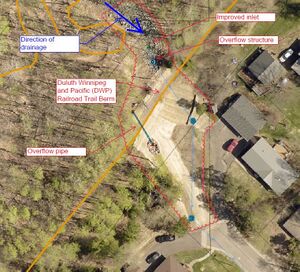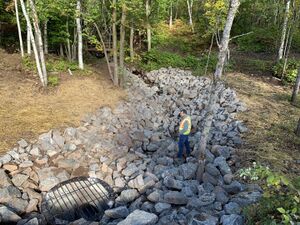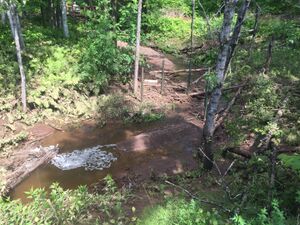
Climate Adaptation Case Study: City of Duluth 82nd Ave W Storm Water Inlet Improvement Project
Climate change has resulted in a higher frequency of high-intensity rainfall events, and higher annual rainfall totals throughout the state of Minnesota. Aging storm water infrastructure constructed based on available design guidance and best practices at the time of construction may no longer be sufficient to convey runoff from higher intensity rainfall events observed over the past decade. For this reason, retrofit projects to add resiliency, storage capacity, and additional conveyance capacity to storm water infrastructure will be required to maintain performance of the storm water conveyance network and protect infrastructure.
In 2019, the City of Duluth in conjunction with Superior Construction Inc. completed the 82nd Ave W storm water inlet improvement project. The 82nd Ave W storm water inlet conveys flow from an upstream drainage area into storm sewer infrastructure along 82nd Ave W. Higher intensity rainfall events observed over the past decade has increased channel erosion in the upstream ravine, leading to more-frequent blockages of the existing inlet. When the inlet is blocked by sediment and woody debris, water overtops the Duluth Winnipeg and Pacific (DWP) railroad trail berm, leading to degradation of the trail subbase, and water damage to residential properties down-gradient of the berm. In June of 2019, an intense rainfall event lead to extensive property damage and initiated emergency work to open and stabilize the existing 30 inch inlet.
Project planning for the inlet improvement project began in June 2019 and the project was completed by early November 2019. In addition to increasing the size of the primary inlet from 30 inches to 36 inches and stabilizing the channel up gradient of the primary inlet structure, a new secondary overflow structure was incorporated to allow runoff to enter the storm sewer when the primary inlet is clogged or blocked. Additionally, an emergency overflow pipe was constructed through the trail berm to provide additional conveyance capacity, reduce/eliminate berm overtopping, and direct excess flows away from down-gradient residential properties.
Completion of the project has yielded a significant reduction in erosion around the primary inlet, eliminated water piping through the DWP trail berm stabilizing sections of the trail, and eliminated further damage to down-gradient residential properties.
Throughout the project, public outreach was conducted to educate residents about the sources and causes of blockages, due to misconceptions that blockages and increased runoff were related to construction of new trails within the watershed to the ravine. The project planner at the City of Duluth indicated that the success of this project was related to holistic planning and perspective throughout (e.g., be considerate of inlet maintenance and access during design, incorporate redundancy to allow for conveyance during blockage, etc.).
For more information regarding this 82nd Ave W storm water inlet improvement project, contact Todd Carlson, Stormwater Project Coordinator and/or Tom Johnson, Stormwater Engineer for the City of Duluth.
Project overview
- Project Location: Duluth, MN
- Completion Date: November 2019
- Design / Construction: City of Duluth / Superior Construction Inc.
- Project Cost: $45,000 for construction, 100 hours of staff time.
- Quantitative Outcomes: Reduced erosion around 30 inch inlet structure, eliminated water piping through the railroad grade, stabilized natural surface trail and protected downstream public and private property from future damage.
This page was last edited on 8 December 2022, at 14:26.



